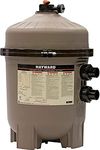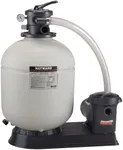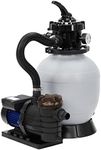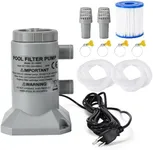Buying Guide for the Best Sand Filter For Inground Pools
Choosing the right sand filter for your inground pool is crucial for maintaining clean and clear water. A sand filter works by filtering out debris and particles from the pool water, ensuring a safe and enjoyable swimming experience. When selecting a sand filter, it's important to consider several key specifications to ensure it meets your pool's needs and provides efficient filtration.Filter SizeThe filter size refers to the capacity of the sand filter to handle the volume of water in your pool. This is typically measured in square feet of filter area or gallons per minute (GPM). A larger filter size can handle more water and debris, making it suitable for larger pools. For smaller pools, a smaller filter size may be sufficient. To determine the right size for your pool, consider the pool's volume and the pump's flow rate. A good rule of thumb is to choose a filter that can handle the pool's total volume in about 8 hours.
Flow RateThe flow rate is the amount of water that can pass through the filter in a given time, usually measured in gallons per minute (GPM). This spec is important because it needs to match the flow rate of your pool pump. If the flow rate of the filter is too low, it won't be able to keep up with the pump, leading to inefficient filtration. Conversely, if it's too high, it can cause excessive wear on the filter. To pick the right flow rate, check your pool pump's specifications and choose a filter with a compatible flow rate.
Filter MediaThe filter media is the material inside the filter that traps debris and particles. For sand filters, this is typically high-grade silica sand. The quality and type of sand can affect the filter's performance. Some filters also allow for alternative media like glass or zeolite, which can offer better filtration and longer life. When choosing the filter media, consider the level of filtration you need and the maintenance requirements. High-quality sand or alternative media can provide better performance and require less frequent replacement.
Valve TypeThe valve type on a sand filter controls the flow of water through the filter. Common types include multiport valves and slide valves. Multiport valves offer multiple settings, such as filter, backwash, rinse, and waste, providing more flexibility and ease of use. Slide valves are simpler but may not offer as many options. When choosing a valve type, consider how often you'll need to change the filter settings and your preference for ease of use. Multiport valves are generally more convenient for regular maintenance.
Durability and Build QualityDurability and build quality refer to the materials and construction of the sand filter. A well-built filter made from high-quality materials will last longer and perform better. Look for filters made from corrosion-resistant materials like high-density polyethylene or fiberglass. These materials can withstand harsh pool chemicals and outdoor conditions. When selecting a filter, consider the environment in which it will be used and the expected lifespan. Investing in a durable filter can save you money and hassle in the long run.
Maintenance RequirementsMaintenance requirements include the ease of cleaning and replacing the filter media. Sand filters typically need to be backwashed periodically to remove trapped debris and maintain efficiency. Some filters have features that make this process easier, such as a clear sight glass or a built-in pressure gauge. When choosing a filter, consider how much time and effort you're willing to spend on maintenance. Filters with user-friendly maintenance features can make the upkeep process simpler and more convenient.


















